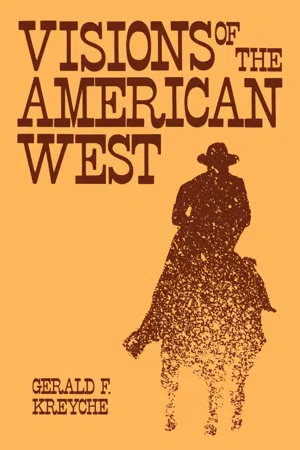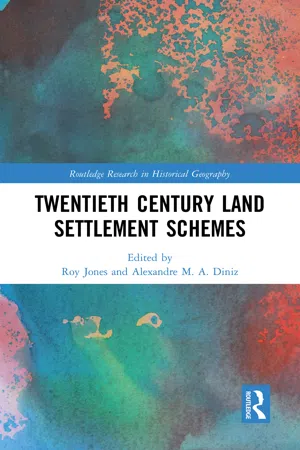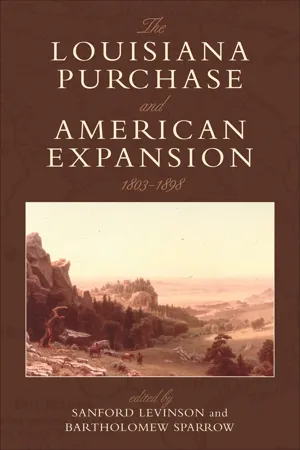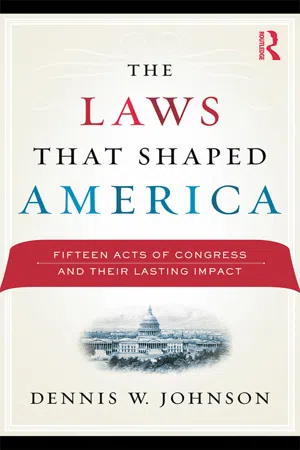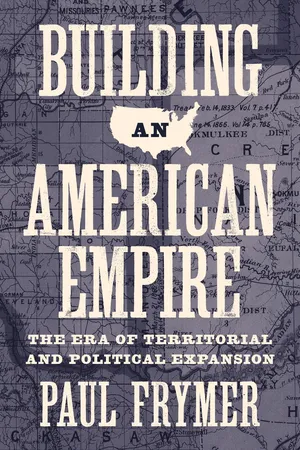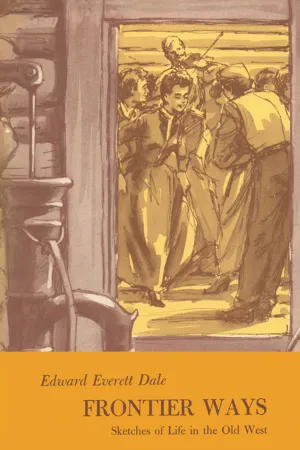History
Homesteaders
Homesteaders were individuals who settled and developed land in the western United States during the 19th century under the Homestead Act of 1862. They were typically farmers and families seeking new opportunities and a fresh start. Homesteaders played a significant role in the westward expansion of the United States, contributing to the development of agriculture and communities in previously unsettled territories.
Written by Perlego with AI-assistance
Related key terms
Related key terms
1 of 4
Related key terms
1 of 3
11 Key excerpts on "Homesteaders"
- eBook - ePub
- Gerald F. Kreyche(Author)
- 2021(Publication Date)
- The University Press of Kentucky(Publisher)
“It provided that lands not sold should be reduced in price over a period of 30 years.” 2 This law was replaced by the momentous Homestead Act of 1862, signed into law by President Lincoln in the middle of the Civil War. The Homestead Act authorized “any citizen or intended citizen [age 21 or over] to select any surveyed land up to 160 acres and to gain title to it after five years’ residence, making prescribed improvements, and paying a modest fee for the service of the register and the receiver.” 3 It also provided that, after a six-month stay, if the resident wished to borrow on the land for its improvement, the “homestead entry” could become a “pre-emption entry.” This allowed the resident to purchase the land at $1.25 per acre, receiving full title later. Westerners still weren’t satisfied, correctly arguing that 160 acres of what Webster called “vast, worthless land” could not support them as did the rich bottomlands of the East. The East, by way of the Congress, agreed and in 1873 passed the Timber Culture Act. It specified that a resident could obtain an additional 160 acres by planting a fourth of the land in trees within a four-year period. Although a great help to the farmer, the act did little for the forestation of the barren lands. Various other land acts, catering more to special interests, were passed in 1877 and 1878. As a result of all these acts of Congress, over one -and -a -half -million land grant applications were approved. The Westward movement was stanched during the Civil War, but immediately at its close the floodgates burst and a new group of people streamed in that direction. They were the Homesteaders, a remarkable people who cut their own niche in American history. Some were farmers who had worn out their land. Others were Union soldiers, whose service exempted them from the five-year residence requirement. Some were freed slaves seizing an opportunity they had never dreamed possible - eBook - ePub
- Roy Jones, Alexandre M.A. Diniz, Roy Jones, Alexandre M.A. Diniz(Authors)
- 2018(Publication Date)
- Routledge(Publisher)
However, the expansion of the United States' continental territory in the 1840s and 1850s brought about a marked increase in the imperative to settle the western United States (Krall 2001). Considerable division over how this was to be achieved remained, however, and, in 1851, 1852 and 1854, homesteading legislation was passed in the US House of Representatives, only to be rejected in the Senate (Kent Rasmussen 2009). A further attempt in 1860 saw President Buchanan veto the bill. The secession of the southern states from the Union shifted the political dynamics considerably and, in 1862, the Homestead Act was passed. Under the provisions of the US bill, settlers 21 years of age or older who were, or intended to become, citizens and who acted as heads of households could acquire tracts of 160 acres of surveyed public land free of all but $10 registration payments. Titles to the land went to the settlers after five years of continuous residence. Alternatively, after only six months, the claimants could purchase the land for $1.25 per acre. Over the years, amendments and extensions of the act made it applicable to forest land and grazing land and increased the maximum acreage tract that individual settlers could acquire (Mikesell 1960).Importantly, the Homestead Act was not passed in isolation and, later in 1862, the Pacific Railroad Act was passed in order to improve transport between industrial regions and the nation's newly emerging agricultural areas (Billings 2012). By the 1930s, 285 million acres had been allocated under the Homestead Act. While the overall success of the Act remains open to debate (Billings 2012), it nevertheless played a critical role in the settling of large areas of the western United States. Moreover, as a policy instrument, it has had considerable influence beyond its immediate jurisdiction.To the north, the newly confederated Dominion of Canada expanded rapidly westward through the purchase of a vast area of land held by the Hudson's Bay Company in 1870 (Gerhard 1959). This area today covers northern Quebec and Labrador, northern and western Ontario and much of Saskatchewan, Manitoba, Nunavut and Alberta. One of the central objectives of the Dominion government was to increase economic development, particularly on the Canadian prairies, through the expansion of agricultural enterprise. In developing these regions, Canada drew heavily on American land settlement ideas (Mackintosh and Joerg 1934). From 1871, the Dominion Lands Survey adopted a modified version of the American square or township and range system, with the newly acquired lands being divided into six-mile-square townships containing 36 sections of 640 acres. Each section was divided into “fourths” comprising 160 acres. For Richtik (1975), the adoption of the American system was partly a matter of convenience, in that it provided a framework that would rapidly and accurately provide the country with an orderly pattern of land settlement. However, he also notes that competition with the United States for settlers was critical given the existence of the 1862 Homestead Act. The prevailing view was that any Canadian system of homesteading needed to at least match the offering south of the border (Richtik 1975). Perhaps not surprisingly, therefore, Canada's response, the Dominion Lands Act, bears striking similarities to its American counterpart. - eBook - ePub
Food Insecurity
A Reference Handbook
- William D. Schanbacher, Whitney Fung Uy(Authors)
- 2023(Publication Date)
- Bloomsbury Academic(Publisher)
The Homestead Act of 1862 was another impactful piece of legislation that was largely detrimental to Native Americas. Under the act, the government enabled adult male citizens to claim up to 160 acres of surveyed land. This contributed to increased western expansion, which further dispossessed Native Americans. Although the intent of the act was to encourage Homesteaders, much of the land that was claimed went to land speculators, loggers, miners, and cattle ranchers and for railroad construction (“Homestead Act (1862),” n.d.).During the period from 1863 to 1939, approximately half a million households received titles to 246 million acres of land, or roughly, 20 percent of U.S. land was given to around two million households. This new European form of land parceling and enclosure of common lands was, in many ways, anathema to the Indigenous conception of land and how it was to be inhabited. Moreover, given that indentured servants, recent immigrants, and slaves were barred from citizenship, the Homestead Act largely benefited white males.Through the parceling of land across the country, the Homestead and Morrill Acts—along with other conciliatory pieces of legislations—compensated Indigenous tribes with only a sliver of what that land was worth in comparison to the income it is generating today. For example, with respect to the Morrill Act, although estimates are difficult to determine, over 500,000 acres of unwillingly donated land remain in trust for at least 12 universities, and in 2019, estimates suggest that more than $5.4 million was generated in college revenue. Groundbreaking reports by High Country News on the lasting effects of the land-grant university system of land appropriations found that Indigenous people remain largely absent from student populations, staff, faculty, and the curriculum (Ahtone 2020).Reconstruction Era (1865–1877)After the passage of the Thirteenth Amendment and the official abolition of slavery, the United States entered a paradoxical new period of both opportunity and harsh oppression known as the Reconstruction Era (1865–1877). The Civil Rights Act of 1875 afforded freed slaves with new hopes and opportunities including the prohibition of public discrimination and inclusion in jury services. However, these short-lived changes were soon challenged in a series of court cases that culminated in the infamous Plessy v. Ferguson - eBook - ePub
Constitutional Thinking
Family and Change in the American Constitutional Order
- Mark E. Brandon(Author)
- 2014(Publication Date)
- University Press of Kansas(Publisher)
Substantively, they contributed in fundamental ways to the political, economic, and moral constitution of the expanding nation. National policy profited from these substantive contributions. On the political and economic fronts, however, there was a complication: nineteenth-century American culture housed at least two distinct conceptions of political economy—one agrarian republican (espoused by Thomas Jefferson), the other liberal capitalist (whose articulate early proponent was Alexander Hamilton). Each posited its own values and its own place for family. The United States’ policy of territorial expansion embodied the tensions between these two conceptions, as Congress pursued both simultaneously. Although this ecumenical embrace partially reconciled the two conceptions, it didn’t suppress conflict entirely. For one thing, there was a persistent political cleavage between Homesteaders and speculators. This division, which grew out of competing material interests that were tied to conflicting notions of political economy, pitted an image of the familial farm against that of an individualist market of free laborers. The cleavage was visible not only in Congress, but also on western turf. For another, national policy toward settlement was inextricably bound to the growing sectional conflict over the status and fate of slavery in the order. On the frontier, as we’ve already seen, sectional conflict pitted two versions of the agrarian family against each other. One was the slaveholding household, which viewed its landed entitlement as prior to the nation. The other was a white, non-slaveholding household that traced its landed entitlement directly to the national government.Even on the eve of the Civil War, members of Congress and the president were engaged in political pugilism on both the class-based front and the sectional front. Despite the adoption of the Republican Party’s Homestead Act after Abraham Lincoln’s election in 1860, which would seem to have been a victory for white Homesteaders against both speculators and slavery (or, if not slavery, against black settlement), western agrarians criticized national policy as wed to capitalism.Amid all the commotion, however, Congress was clear and consistent about one thing: family’s function was to maintain (and extend) political dominion into the territories and across the continent. Would family comply with Congress’s expectations? Western families did indeed help maintain and extend the authority of the nation across the continent. They were both essential and useful to this task. They were essential for two reasons. first, agriculture was the primary mode of production on the frontier; second, the means for pursuing agriculture tended to make family, not the individual, the basic unit capable of material self-sufficiency. Families were useful to the task, because connections among families created communities, which were the basis for a rudimentary form of politics, which in turn was the foundation for political control of the territories and their admission into the union. - New York Times reporter called me, looking for a regional image to go with the dead mule of southern literature. I suggested “leaving the homestead,” a motif running through both memoirs and fiction and grounding what we are to mean by asking how the Homestead Acts, in aggregate, succeeded or failed.Hamlin Garland, born in Wisconsin and raised on an Iowa farm, came to Brown County, South Dakota, with his parents as a teenager. He later settled on his own quarter section pre-emption claim long enough to be able to sell (he says “mortgage,” but that appears to be a euphemism) what was apparently a relinquishment, since the land had apparently still not been surveyed, for $200 and to move to Boston, where he educated himself to be an American man of letters, apparently his goal even as a schoolboy in Iowa. Garland’s first claim to fame came as the author of short stories about the grimness of farm life. He focussed especially on the plight of women, the evils of landlordism and land speculation, and the guilt felt by the boy who leaves the farm, makes good, and returns to see the poverty and drudgery still suffered by the people he left behind. There is a certain irony in the fact that Garland, that devout follower of Henry George and the scourge of the land speculators, got his own professional start by an extralegal bit of speculation, holding down a pre-emption claim during a Dakota winter for the sake of selling a relinquishment. On the other hand, Garland was making a rational choice. His stories make it abundantly clear that, despite his love for the beauty of the land, particularly in the Wisconsin Coulee country, he had no aptitude for being a farmer but rather a burning desire to be a man of letters. Selling his claim gave him a tidy nest egg that he could not easily have obtained in any other fashion. Garland was unusual only in that he used his nest egg to go to Boston and to read through the public library rather than attending the University of Wisconsin or Iowa State or one of the various normal schools in the Midwest. A self-made (and intensely self-conscious) man of letters is always a rarity. Selling either land or a relinquishment to fund post-secondary education for oneself or one’s children was probably a more common pattern, but the most common pattern was turning homestead land to money in order to fund some kind of business—as Garland’s father did, running a store in town.18
- Sanford Levinson, Bartholomew Sparrow, Sanford Levinson, Bartholomew Sparrow(Authors)
- 2023(Publication Date)
- Stackpole Books(Publisher)
57 For them, Congress’s act of offering a homestead to anyone who would settle on the land and cultivate it was nothing more than a gratuity: one that the government could deny or withdraw at its discretion.CONCLUSION
Expansionists of the 1840s maintained that America could absorb, acquire, and conquer the new territory in the West without consequently acquiring the baggage of imperialism. American expansion, they argued would be nothing like the European imperialism they so despised. Where European imperialism tended to strengthen and reinforce an aristocratic elite, American expansion would have a leveling effect that would strengthen representative democracy and protect liberty. This was possible, they said, because the acquisition of new territory in the West would provide an opportunity for widespread ownership of land. The resulting explosion of the class of independent small farmers would reduce to insignificance the influence of connected elite on the democratic process.The expansionist promise presumed that the newly acquired public domain would be distributed in a way that encouraged widespread ownership of the land. Land reformers picked up on this theme and pressed for a land policy that provided cheap or free land in small plots to actual settlers. Despite the enactment of the Homestead Act of 1862 and other reform legislation, however, the idea of distributing public domain directly to actual settlers never dominated federal land policy. Inconsistent federal legislation removed millions of acres from the pool of land that might otherwise have been available for homesteading and created an environment that assured conflict between settlers and large landholders. When such conflict reached the courts, judicial interpretation of federal land laws tended to be hostile to homesteading. By the 1890s it was inescapable that land reform had failed to achieve its goal.- eBook - ePub
The Laws That Shaped America
Fifteen Acts of Congress and Their Lasting Impact
- Dennis W. Johnson(Author)
- 2009(Publication Date)
- Routledge(Publisher)
81The Homestead Act, however, treated the South differently. Southern farmers and would-be settlers were frozen out of the free lands until after the end of the war, and there were strong sentiments in Congress to continue to treat the South differently. Before 1861, there were nearly 48 million acres of federal public land, almost one-third of the entire territory of Alabama, Arkansas, Florida, Louisiana, and Mississippi. Much of that land was swampfilled, or of poor timber quality, and had been for sale before the war at prices ranging from 12.5 cents to one dollar an acre.82The South became the laboratory for land policy experimentation. From 1866 to 1876, southern public lands were reserved for Homesteaders only, and it was illegal to make large land purchases. Congressman George W. Julian (Republican–Indiana), a long-time abolitionist and the chairman of the House Public Lands Committee, wanted to restrict southern homesteading only to loyal citizens and to break up the old southern aristocracy. In 1866, pushed on by the Radical Republicans, Congress enacted the Southern Homestead Act, which restricted the southern public lands to parcels of 80 acres each to be given only to individual Homesteaders. With the southern states being readmitted over the next years, one of the first things that southerners wanted to do was repeal the 1866 law. To many, the Southern Homestead Act was another insult, of northerners trying to rub the war into their noses and retard growth and economic prosperity. Finally, in 1876, after a long, heated fight, with southern lawmakers unified in their determination, the 1866 law was repealed. Now, the South was open once again to land and timber speculation. But ironically, it was monied interests from the North that swooped down and bought control of the best land, the best cypress and yellow pine acres, and reaped the profits from the southern timber industry.83 - eBook - ePub
Princeton Studies in American Politics
The Era of Territorial and Political Expansion
- Paul Frymer(Author)
- 2017(Publication Date)
- Princeton University Press(Publisher)
87With most southerners gone from Congress, the Homestead Act was finally passed quite easily in 1862. It allowed settlers to receive the land for free or purchase land for $1.25 per acre (in addition to a $10 entry fee), after residing continuously on the property for five years, and was followed by similar legislation such as the Timber Culture Act and Desert Land Act that further provided settlers with cheap or free land if they cultivated and resided on it for a set number of years. Although its achievements never met its grandiose ambitions, the Homestead Act nonetheless distributed more than 96 million acres with over 718,000 individual entries over the next four decades, providing a leading catalyst for population explosions in a number of western states.88 Western states were granted more than 72 million acres of land from the Act. Many of these were sold at high prices in auctions and gobbled up by speculators.89 Homestead lands were selectively made available, and as the government made pronouncements of land openings, often before treaties were signed with Indian nations, settlers frequently rushed to contested territories in areas such as the Dakotas, Minnesota, and Utah, just as the government did with bounty lands in earlier decades.90 The government also offered huge land grants to railroads to further spur settlement, particularly in faraway locales, and the railroads themselves invested time in recruiting immigrants from northern Europe to bring both as laborers to work on the railroads and as settlers who would buy land from their grants.91FIGURE 4.7. Homesteads by state, 1880–1904. Report of the Public Lands Commission, “Final Homesteads,” 58th Congress, 3d - eBook - ePub
Food in America
The Past, Present, and Future of Food, Farming, and the Family Meal [3 volumes]
- Andrew F. Smith(Author)
- 2017(Publication Date)
- ABC-CLIO(Publisher)
Of the estimated 500 million acres of public-domain land that passed into private ownership from 1862 to 1904 as a result of this Act, only 80 million acres went to small farmers and other Homesteaders. The remaining 420 million acres ended up in the possession of speculators and corporate interests. Following is the complete text of the Homestead Act. An Act to secure Homesteads to actual Settlers on the Public Domain. Be it enacted by the Senate and House of Representatives of the United States of America in Congress assembled, That any person who is the head of a family, or who has arrived at the age of twenty-one years, and is a citizen of the United States, or who shall have filed his declaration of intention to become such, as required by the naturalization laws of the United States, and who has never borne arms against the United States Government or given aid and comfort to its enemies, shall, from and after the first January, eighteen hundred and sixty-three, be entitled to enter one quarter section or a less quantity of unappropriated public lands, upon which said person may have filed a preemption claim, or which may, at the time the application is made, be subject to preemption at one dollar and twenty-five cents, or less, per acre; or eighty acres or less of such unappropriated lands, at two dollars and fifty cents per acre, to be located in a body, in conformity to the legal subdivisions of the public lands, and after the same shall have been surveyed: Provided, That any person owning and residing on land may, under the provisions of this act, enter other land lying contiguous to his or her said land, which shall not, with the land so already owned and occupied, exceed in the aggregate one hundred and sixty acres. SEC. 2 - eBook - ePub
Civil War America
Farming, Antislavery Politics, and Nature Parks in the Civil War Era
- Adam Wesley Dean(Author)
- 2015(Publication Date)
- The University of North Carolina Press(Publisher)
56William S. Holman, a war Democrat from Indiana who voted with Republicans on land policy, believed that the Homestead Act would make the Union stronger by cultivating a society of small farmers in the West. “In my judgment,” he said, “the policy of applying the public lands in such manner as to increase the number of independent farmers, of secure and independent homesteads, decentralizing and diffusing the wealth of the nation, is of the very first importance; vital, indeed, to the ultimate stability of the Republic.” Holman blamed slaveholding aristocrats for starting the war. Diffusing wealth and land ownership would prevent further upheaval. “The greatest of the English statesmen finds the causes of internal war, seditions and factions organized against the Government,” he explained, “in the centralization of the wealth, and especially the lands of a nation, destroying the interest of the people in the stability of the nation. . . . Instead of baronial possessions, let us facilitate the increase of independent homesteads.” The Indianan also worried that if the North failed to reunite the nation and provide for widespread material plenty, “the monarchists and aristocrats of the world would [exult] . . . that the government of the many was inconsistent with the nature of man.”57Wartime contingencies also had a large influence on the homestead debate. In late 1861 and early 1862, some Republicans urged rapid passage of the law to strike against slavery before emancipation and before southerners returned to Congress. Their statements show how questions of land development and slavery were intertwined. “We know the source of opposition to this bill,” John Fox Potter reminded his colleagues. “We know from whence has proceeded such opposition heretofore. It is from the very men who are now engaged in a wicked rebellion against this Government . . . that is the class of people who are opposed to the adoption of this policy.” George Julian believed that slavery caused the rebellion. He warned: “The mere suppression of this rebellion will be an empty mockery of our suffering and sacrifices, if slavery shall be spared to canker the heart of the nation anew, and repeat its diabolical deeds.” The homestead bill, Julian claimed, “recognizes the inalienable rights of the people and the dignity of labor, and thus brands the slave power as no act of the nation ever did before.” Homesteads would also end land monopoly, which Julian believed was another cause of secession. The Indianan argued that the Confederacy was a “rebellious aristocracy founded on the monopoly of land and the ownership of Negroes.”58 - eBook - ePub
Frontier Ways
Sketches of Life in the Old West
- Edward Everett Dale(Author)
- 2010(Publication Date)
- University of Texas Press(Publisher)
AMID THE TURMOIL of civil war, the Congress of the United States passed the Homestead Act. This granted 160 acres of land from the public domain to every person 21 years of age or the head of a family who was a citizen of the United States or had declared his intention of becoming a citizen and who did not already own more than 160 acres of land elsewhere. During the stress of war no large number of persons took advantage of this but immediately after the close of the conflict, and the return of so many thousands of soldiers to civil life, there was a great outpouring of eager homeseekers to the Prairie West. By 1870 this movement had gathered enormous momentum and during the next two decades the increase of population in most states forming the second tier west of the Mississippi River was truly startling. During the next decade the increase continued and Oklahoma Territory’s population grew from 61,000 in 1890 to 400,000 in 1900. Montana, Wyoming, Colorado, and New Mexico show a similar trend.Regardless of the state or the region in which the homesteader settled, his first desire was to become acquainted with his neighbors. He was above all eager to know what sort of people these were among whom he had cast his lot. Were some of them natives of his own state or members of his own church? How many children were in the community who might be brought into a school or Sunday School? Were these nearby settlers a kindly and hospitable people who would make good neighbors, and among whom he could live on friendly terms and with mutual respect and confidence? On the answer to these questions depended to a great extent the future happiness and well being of the new homesteader and his family.He soon discovered that neighboring settlers were asking themselves exactly the same questions about him. In a new country co-operation and the development of a community consciousness is most important. The answers to such questions were, moreover, in most cases satisfactory. The people who came to these new prairie regions did so to make homes for themselves and their families. They were for the most part an honest, industrious, God-fearing folk eager to succeed and to build up a stable society in a raw and untamed land. Any members of the rougher element that had drifted in soon found themselves so far outnumbered that they departed in search of more congenial associates and an environment more suited to their tastes.
Index pages curate the most relevant extracts from our library of academic textbooks. They’ve been created using an in-house natural language model (NLM), each adding context and meaning to key research topics.
Explore more topic indexes
Explore more topic indexes
1 of 6
Explore more topic indexes
1 of 4
